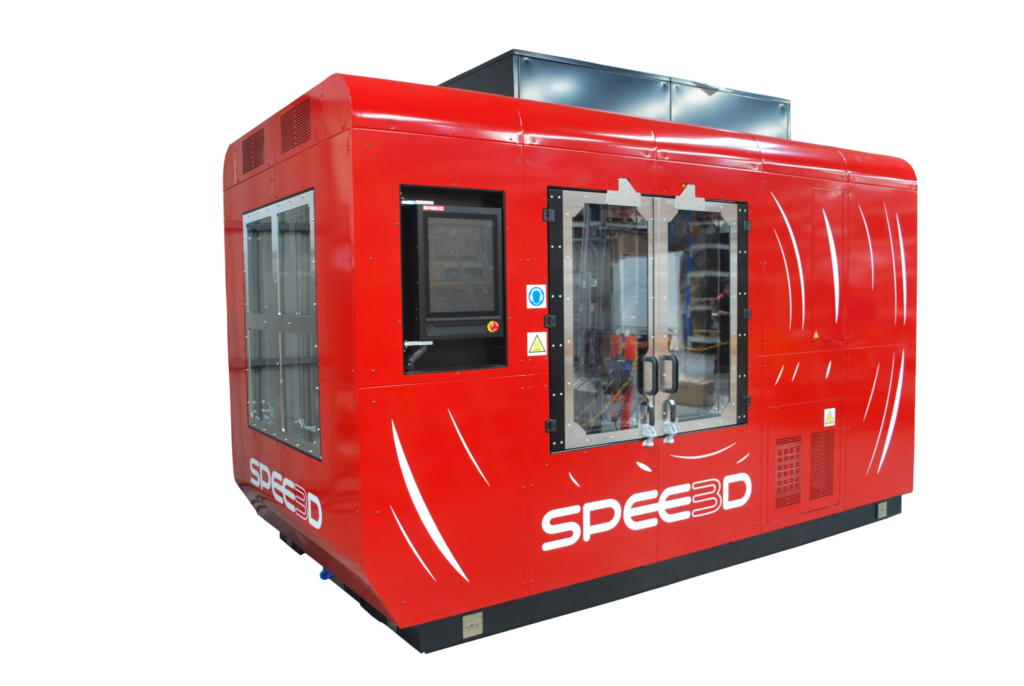Australian 3D printing firm SPEE3D has an inexpensive and very productive 3D printing technology that is hereto been known mainly for its potential in austere environments. The cold spray firm has been focusing on containerized 3D printers and working with the British, US and Australian Army on printers for the field. Rocketry is new to SPEE3D, however, and, on September 16th, the company performed a successful stationary hot fire test on a 3D printed rocket engine prototype.
As a part of the SPACE3D program, SPEE3D aims to build and make reusable rocket engines using its cold spray technology. Over the next year-and-a-half, the company will continue to produce rocket comments under a $1.25 million grant from Australia’s Modern Manufacturing Initiative and a grant of $312,000 from the Northern Territory.
“SPEE3D‘s cold spray technology facilitates new ways to design and manufacture demanding space components potentially more rapidly and at a lower cost than incumbent technologies. Our design, manufacturing, and test expertise, once proven by events such as successful rocket engine hot fire tests, will position us well to play an important role in the rapidly expanding space industry,” said Gary Owen, Chief Space Officer for SPEE3D.
“We are thrilled the SPACE3D program is helping to revolutionise the space industry in Australia, and this successful test symbolises a significant step forward. By developing the local space industry, we are creating more employment opportunities for innovative Territorians and expanding our advanced manufacturing capabilities. The Territory is the place to do business, and we back ambitious projects to create more jobs and a stronger future,” said Nicole Manison, Minister for Advanced Manufacturing.
A couple of things of note here: First off, Australia has a Minister for Advanced Manufacturing and no one told me? Secondly, Chief Space Officer is the coolest title ever. The low cost of SPEE3D’s technology and its ability to print copper- and nickel-based carbides is decidedly an advantage as well. Having said that, if you would have come to me wanting to 3D print a rocket engine, I wouldn’t have initially thought of introducing you to the nice people at SPEE3D. Cold spray isn’t the first technology that would have come to mind. However, given all the work in hypersonics and excitement about New Space, Australia’s promotion of its local 3D printing technology is more than justified.
3D Printing Allows Australia to Re-localize Manufacturing
Blessed with a lot of land and much in the way of natural resources, Australia is a wealthy country with a mixed economy. However, it struggles to stay relevant on the latest startup-heavy areas and in cutting edge technologies. Its mining companies are also very dependent on selling to China, an outsized investor in Australia and buyer of its goods. More recently, the People’s Republic has become more assertive in its moves to influence Australian politics. The two nations rising together peacefully has become somewhat less likely and Australia´s blissful remoteness and closeness to China seems like more of a liability.
Supply chain interruptions, dependence on the foreign country for technology intermediates, and geological isolation have led to more thinking consideration for resilient supply chains. Therefore, SPEE3D stands to gain in a scenario that Australia is trying to make more of its defense itself. The government is sure to pour much more money into its 3D printing ecosystem in the years to come.
For an isolated country which is almost impossible to defend, 3D printing promises the ability to make the latest weaponry locally, and to repair those weapons quickly as they fail. In space, the ability to make and launch rockets nationally would also give the country a nice new industry and geopolitical clout. Space technology would furthermore give the country access to fleets of satellites and missiles so that it could realistically deter an invasion. It is surely a portend of very good times to come for 3D printing in Australia that the company needs this technology to ensure its national safety.
Subscribe to Our Email Newsletter
Stay up-to-date on all the latest news from the 3D printing industry and receive information and offers from third party vendors.
You May Also Like
Gorilla Sports GE’s First 3D Printed Titanium Cast
How do you help a gorilla with a broken arm? Sounds like the start of a bad joke a zookeeper might tell, but it’s an actual dilemma recently faced by...
Nylon 3D Printed Parts Made More Functional with Coatings & Colors
Parts 3D printed from polyamide (PA, Nylon) 12 using powder bed fusion (PBF) are a mainstay in the additive manufacturing (AM) industry. While post-finishing processes have improved the porosity of...
$25M to Back Sintavia’s Largest Expansion of Metal 3D Printing Capacity Since 2019
Sintavia, the digital manufacturing company specializing in mission-critical parts for strategic sectors, announced a $25 million investment to increase its production capacity, the largest expansion to its operations since 2019....
Velo3D Initiates Public Offering in a Bid to Strengthen Financial Foundations and Drive Future Growth
Velo3D (NYSE: VLD) has been among a number of publicly traded 3D printing firms that have attempted to weather the current macroeconomic climate. After posting a challenging financial report for 2023,...

































